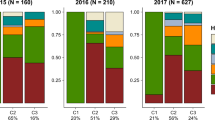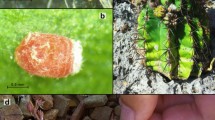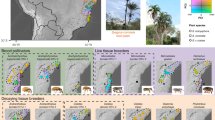Abstract
Possible mechanisms for animal speciation in the absence of geographic isolation remain controversial. Univoltine flies of the Rhagoletis pomonella sibling species group of larval fruit parasites have been cited1–5 as prime examples of sympatric speciation through divergence in host plant association. The recent emergence of several populations of R. pomonella associated with plants other than the fly's native hawthorn host has been attributed to the effects described by a model2–4 of sympatric host-race formation involving host recognition and survival genes; however, direct genetic evidence of biologically meaningful differentiation among putative host races has been lacking. In contrast, the potential importance of seasonal asynchrony (of flies adapted to host plants with different fruiting phenologies) in initial restriction of gene flow has been largely undervalued. Here I report heritable divergence in seasonal emergence of R. pomonella flies collected from sympatric populations on three host plant species in Illinois, in the United States.
This is a preview of subscription content, access via your institution
Access options
Subscribe to this journal
Receive 51 print issues and online access
$199.00 per year
only $3.90 per issue
Buy this article
- Purchase on Springer Link
- Instant access to full article PDF
Prices may be subject to local taxes which are calculated during checkout
Similar content being viewed by others
References
Bush, G. L. Bull. Mus. comp. Zool. Harv. 134, 431–562 (1966).
Bush, G. L. Evolution 23, 237–251 (1969).
Bush, G. L. in Genetic Mechanisms of Specialion in Insects (ed. White, M. J. D.) 3–23 (Australian and New Zealand Book, Sydney, 1974).
Bush, G. L. in Evolutionary Strategies of Parasitic Insects and Mites (ed. Price, P. W.) 187–206 (Plenum, London, 1975).
Bush, G. L. & Diehl, S. R. in Insect-Plant Relationships (eds Visser, J. H. & Minks, A. K.) 297–305 (Pudoc, Wageningen, 1982).
Smith, D. C. J.N.Y. ent. Soc. (in the press).
Tauber, M. J., Tauber, C. A. & Masaki, S. Seasonal Adaptations of Insects (Oxford, New York, 1986).
Jaenike, J. Am. Nat. 117, 830–834 (1981).
Diehl, S. R. & Bush, G. L. A. Rev. Ent. 29, 471–504 (1984).
Reissig, W. H. Can. Ent. 109, 631–634 (1977).
Opp, S. B. & Prokopy, R. J. Fla. Ent. 70, 449–457 (1987).
Pickett, A. D. & Neary, M. E. Scient. Agric. 20, 551–556 (1940).
Reissig, W. H. & Smith, D. C. A. ent. Soc. Am. 71, 155–159 (1978).
Futuyma, D. J. & Mayer, G. C. Syst. Zool. 29, 254–271 (1980).
Smith, D. C. dissertation, Univ. Illinois (1986).
Slatkin, M. A. Rev. Ecol. Syst. 16, 393–430 (1985).
Paterson, H. E. H. S. Afr. J. Sci. 77, 113–119 (1981).
Futuyma, D. J. & Peterson, S. C. A. Rev. Ent. 30, 217–238 (1985).
McPheron, B. A., Smith, D. C. & Berlocher, S. H. Genetics 119, 445–451 (1988).
Author information
Authors and Affiliations
Rights and permissions
About this article
Cite this article
Smith, D. Heritable divergence of Rhagoletis pomonella host races by seasonal asynchrony. Nature 336, 66–67 (1988). https://doi.org/10.1038/336066a0
Received:
Accepted:
Issue Date:
DOI: https://doi.org/10.1038/336066a0
This article is cited by
-
Seasonal specialization drives divergent population dynamics in two closely related butterflies
Nature Communications (2023)
-
Preference, performance, and chemical defense in an endangered butterfly using novel and ancestral host plants
Scientific Reports (2021)
-
Geographic host use variability and host range evolutionary dynamics in the phytophagous insect Apagomerella versicolor (Cerambycidae)
Oecologia (2011)
-
The willow bud galler Euura mucronata Hartig (Hymenoptera: Tenthredinidae): one polyphage or many monophages?
Heredity (2002)
-
The genetics and ecology of sympatric speciation: A case study
Population Ecology (1998)
Comments
By submitting a comment you agree to abide by our Terms and Community Guidelines. If you find something abusive or that does not comply with our terms or guidelines please flag it as inappropriate.



